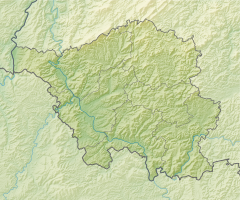Beeder Bruch
|
Beeder Bruch nature reserve
|
||
|
View from the observation pavilion |
||
| location | City of Homburg and municipality of Kirkel , Saarpfalz district , Saarland | |
| surface | 127 km² | |
| Identifier | DE6609308 | |
| WDPA ID | 555595957 | |
| Natura 2000 ID | 6609-308 | |
| Geographical location | 49 ° 19 ′ N , 7 ° 18 ′ E | |
|
|
||
| Setup date | 2015 | |
| administration | State Office for Environmental Protection and Occupational Safety (LUA) Department of Nature Conservation | |
|
Beedener Bruch (EU bird sanctuary)
IUCN category none - not specified |
|
| location | City of Homburg and municipality of Kirkel , Saarpfalz district , Saarland |
| surface | 127 km² |
| WDPA ID | 555537809 |
| Geographical location | 49 ° 19 ' N , 7 ° 18' E |
| Setup date | 2006 |
The Beeder break even Beedener fracture , is a conservation area in the Saarpfalz district and as a bird sanctuary at the same part of the network Natura 2000. .
location
The Beeder Bruch is part of the Bliesgau Biosphere Reserve . It lies in the districts of Homburger neighborhoods Beeden and Schwarzenacker and in the district of Kirkeler district in Old Town .
The almost triangular shaped area is bounded in the north by the state road L 119, in the southeast by Beeden and in the southwest by the Blies . The 30 hectare former Höllengraben nature reserve is located within the Beeder Bruch .
Bird protection
Conservation objective of Beeder break is to secure and develop the function as breeding, resting and wintering area for the following bird species: egrets , Smew , osprey , cranes , Ruff , Wood Sandpiper , widgeon , teal , pintail , teal , shoveler , Hobby , Little Ringed Plover , Lapwing , miniature snipe , common snipe , sandpiper , turtledove , cuckoo , whinchat and oriole . In addition, several pairs of white storks breed in the meadows of the Beeder Bruch.
Landscape protection
The area is part of the Blies floodplain , which is why there are alluvial forest , used and fallow floodplain meadows, ditches and ponds. The predominant communities of floodplain forest, willow-alder-woody plants, wet meadows, reed beds, large sedge areas, tall herbaceous corridors, spring corridors and aquatic plant communities are to be preserved, as they provide a suitable habitat for a large number of rare and endangered plant and animal species.
Recreation area
Under the name "Biotop Beeden", the area is one of the most heavily frequented protected areas in the Bliesgau Biosphere Reserve. In addition to the various bird species, visitors can also observe the water buffalo and Heck cattle , which were settled in 2005, as well as a herd of Konik wild horses. For this purpose, the Beeden Biotope Association maintains a viewing platform on the western edge of the Beeder Bruch and a viewing pavilion.
literature
- Peter Gitzinger: The Beeder Bruch. Water buffalo in the bird sanctuary . In: 111 places in Saarland that you have to see. Volume II . Emons-Verlag, 2011, ISBN 978-3-89705-886-6 , pp. 46-47 .
See also
- List of EU bird protection areas in Saarland
- List of landscape protection areas in the Saarpfalz district
Web links
- Landscape protection areas> L_6609-308_Beeder_Bruch. State Office for Environment and Occupational Safety and Health Saarland, accessed on June 7, 2020 .
- The ecology is improved. (PDF) Expansion of the areas at the Beeder Biotop benefits the animal population. In: Wochenspiegel. December 12, 2012, accessed June 7, 2020 .
Individual evidence
- ↑ a b c d Ordinance on the "Beeder Bruch" landscape protection area (L 6609-308). (PDF) Saarland Official Gazette, December 4, 2014, accessed on June 7, 2020 .
- ↑ a b Water buffalo meets white stork. Press release. Biosphärenzweckverband Bliesgau, April 28, 2011, accessed on June 7, 2020 .
- ↑ Overview map L 6609-308 Beeder Bruch. (PDF) State Office for Environmental Protection and Occupational Safety Saarland, accessed on June 7, 2020 .
- ↑ Bird sanctuary 6609-308 “Beeder Bruch”. (PDF) Conservation goals. State Office for Environment and Occupational Safety and Health Saarland, accessed on June 7, 2020 .




